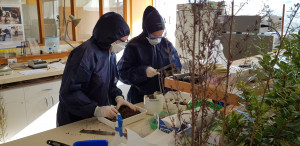Native plant species enlisted to help clean up waterways
A new study underway in Wellington is testing a range of New Zealand native plants for their ability to clean up our waterways.
ESR scientists at the Kenepuru Science Centre in Porirua are looking at the potential of rātā and horopito to reduce the number of bacterial pathogens in soil where dairy shed effluent has been put to land.
Dr Maria Gutierrez-Gines says earlier laboratory tests have shown that the root system of the mānuka trees has an ability to significantly reduce the bacteria counts and nitrate level in soils.
Now, two further species of plants have been selected after also showing antimicrobial potential during a preliminary study where a range of native plants were screened.
Previous greenhouse-based tests have shown that E.coli died off much faster in soils under mānuka than under pasture, and significantly reduced the leaching of nitrate compared to both pasture and pine trees.
ESR scientists have indications that rātā and horopito will show similar properties.
“We already have mānuka planted in field trials to see if it can reduce E.coli from leaching into waterways in a farm catchment. Being able to identifying other plants that work as well or even better than mānuka is the big potential of this study.”
Dr Gutierrez- Gines says another benefit of the research would be to have better biodiversity in riparian plantings, especially in farm catchments.
The ESR-led Centre for Integrated Bio-waste Research (CIBR) is running the trials using locally grown rātā, horopito and mānuka seedlings.
Plants have been irrigated with dairy shed effluent collected from a farm and are undergoing a series of tests to see if the removal of E. coli is faster under those trees.
The scientists involved in the tests have to take extra precautions when working with the collected effluent – wearing masks, gowns and gloves to protect themselves from the risk of exposure to pathogens that may potentially be present.
Dr Gutierrez-Gines says the other challenge has been the odour of the effluent. “It’s a little bit smelly – but I guess that is what you get when you are working with bio-waste.”
ESR’s iwi partners were key in developing the scientific research on mānuka and other native plant species.
“It was in Kaikōura where a representative of Te Runānga o Kaikōura encouraged researchers within the programme to move beyond it’s ‘business as usual focus’ on Pinus radiata as the preferred model species for study and benchmarking of data.”
This initial invitation to better explore the functions of Aotearoa-NZ endemic plant species was extended to the Mokai community (Tirohanga School and Mokai Marae), whānau in the Tairāwhiti, Horowhenua regions, and more recently with Ngāti Kahungunu ki Wairarapa, and with iwi/whānau in Lake Waikare area (Ngā Muka Development Trust, Te Riu o Waikato, Nikau Farm Estate/Matahuru Marae).
“Our iwi partners and whanau were integral to growing and sharing new knowledge to better understand and promote native plantings in restoring eco-system health.”
“E tu kahikatea. Hei whakapae ururoa. Awhi mai awhi atu. Tatou tatou e!”
The kaihikatea stand strong, their roots interconnected strengthening each other against the storm, together we are strong.
For more information, listen to the story on Radio NZ (external link) (external link).

